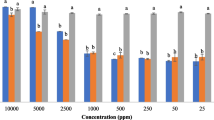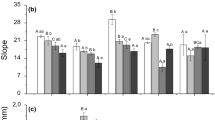Abstract
The objective of this study was to incorporate flaxseed oil, flaxseed flour and fruits for the preparation of fruit yoghurt and analysed for their sensory, physicochemical and fatty acid profile. Overall acceptability of sensory scores indicates that fruit yoghurt (20% fruit and sugar mixture) with incorporation of flaxseed oil up to 2% and flaxseed flour up to 1% in combination can be used for preparation of fruit yoghurt with acceptable sensory attributes. The scores drastically reduced for yoghurt samples wherein 2% flaxseed flour was incorporated. The mixture of sugar and fruits diluted the milk composition and resulted in lower values in the fruit yoghurts. The increase in fat, protein, carbohydrate, minerals content in the yoghurt was mainly contributed by the flaxseed oil and flour. The addition of flaxseed oil did not show any affect on the water activity of the yoghurt samples. The yoghurt had dietary fiber content of 1.24%. The fresh control fruit yoghurt showed the acidity value of 0.88% LA, while the corresponding value for experimental samples varied between 0.85 and 0.88% LA. TBA values increased with increased incorporation of flaxseed oil and flaxseed flour. The fatty acid analysis revealed that alpha linolenic acid (ALA) content increased from 0.45% of ALA in control sample to 22.80% of ALA in the final product.
Similar content being viewed by others
Abbreviations
- FY:
-
Fruit yoghurt
- FY1/1:
-
Fruit yoghurt with 1% flaxseed oil and 1% flaxseed flour
- FY1/2:
-
Fruit yoghurt with 1% flaxseed oil and 2% flaxseed flour
- FY2/1:
-
Fruit yoghurt with 2% flaxseed oil and 1% flaxseed flour
- FY2/2:
-
Fruit yoghurt with 2% flaxseed oil and 2% flaxseed flour
- ALA:
-
Alpha-linolenic acid (ALA)
References
Al-Kadamany EM, Khattar T, Haddad TI (2003) Estimation of shelf life of concentrated yoghurt by monitoring selected microbiological and physiological changes during storage. LWT Food Sci Technol 36:407–414
AOAC (2006) Official methods of analysis, 18th edn. Association of Official Analytical Chemists, Washington
Balasubramanyam BV, Kulkarni S (1991) Standardization of manufacture of high fat yoghurt with natural fruit pulp. J Food Sci Technol 28:389
Bermúdez-Aguirre D, Barbosa-Cánovas GV (2011) Quality of selected cheeses fortified with vegetable and animal sources of omega-3. LWT Food Sci Technol 44(7):1577–1584
Bhatty RS (1995) Nutrient composition of whole flaxseed and flaxseed meal. In: Cunnane S, Thompson L (eds) Flaxseed in human nutrition. AOAC Press, Champain, pp 56–58
Carter JF (1993) Potential of flaxseed and flaxseed oil in baked goods and other products in human nutrition. Cereal Foods World 38(10):753–759
Coskuner Y, Karababa E (2007) Some physical properties of flaxseed (Linum usitatissimum L.). J Food Eng 78:1067–1073
Daun JK, Barthet JV, Chornick TL, Duguid S (2003) Structure, composition, and variety development of flaxseed. In: Cunnane SC, Thompson LU (eds) Flaxseed in human nutrition, 2nd edn. AOCS Press, Champaign, pp 1–40
Davis FL, Shankar PA, Brooker BE, Hobbs DC (1978) A heat induced changes in the ultrastructure of milk and its effects on gel formation in yoghurt. J Dairy Res 45:53
Diaz-Jimenez B, Sosa-Morales ME, Andvelez-Ruiz JF (2004) Effect of fiber adding and fat decreasing on physico-chemical properties of yogurt. Rev Mex Ing Quím 3:287–305 (in Spanish)
Divya KB, Sathish Kumar MH, Mittal V, Sabikhi L (2013) Sensory attributes, fatty acid profile and oxidative stability of low fat buffalo milk supplemented with omega 3 fatty acids and dietary fiber. Indian J Dairy Sci 66:96
Fajardo-Lira C, Garibay MG, Rodarte CV, Farres A, Marshall VM (1997) Influence water activity on the fermentation of yoghurt made with extracellular polysaccharide-producing or non-producing starter. Int Dairy J 7:279–281
Goh KT, Ye A, Dale N (2006) Characterization of ice cream containing flaxseed oil. Int J Food Sci Technol 41:946–953
Gopalan C, Rama Sastri BV, Balasubramanian SC (1989) Nutritive values of Indian foods. National Institute of Nutrition, Hyderabad, pp 25–26 and 47–48
Goyal A, Sharma V, Sihag MK, Singh AK, Arora S, Sabikhi L (2016) Fortification of dahi (Indian yoghurt) with omega-3 fatty acids using microencapsulated flaxseed oil microcapsules. J Food Sci Technol 53(5):2422–2433
Hashim IB, Khalil AH, Afifi HS (2009) Quality characteristics and consumer acceptance of yoghurt fortified with date fiber. J Dairy Sci 92:5403–5407
Helrich K (1990) Official methods of analysis of the association of official analytical chemists, 15th edn. Association of Official Analytical Chemists Inc, Arlington
Hussain S, Anjum FM, Butt MS, Khan MI, Asghar A (2006) Physical and sensoric attributes of flaxseed flour supplemented cookies. Turk J Biol 30:87–92
Hussain S, Anjum FM, Butt MS, Sheikh MA (2008) Chemical compositions and functional properties of flaxseed flour. J Agric 24(4):649–653
ICMR (2010) Nutrient requirements and recommended dietary allowances for Indians. A report of the Expert Group of the Indian Council of Medical Research 2009. http://icmr.nic.in/final/RDA-2010.pdf. Last accessed on 20/01/2016
ISO (2001) Milk and milk products. Extraction methods for lipids and lipid soluble compounds. ISO Norm 14156:2001 (IDF172:2001). International Standardization Organization ed., Geneva, Switzerland
ISO (2002) Milk fat determination of the fatty acid composition by gas-liquid chromatography. ISO Norm 15885:2002 (IDF 184:2002). International Standardization Organization ed., Geneva, Switzerland
ISO (2009). Milk fat from enriched dairy products. Determination of omega-3 and omega-6 fatty acid content by gas-liquid chromatography. ISO Norm 23065:2009 (IDF 211: 2009). International Standardization Organization ed., Geneva, Switzerland
Jensen RG (2002) Invited review: the composition of bovine milk lipids: January 1995 to December 2000. J Dairy Sci 85:295–350
King RL (1962) Oxidation of milk fat globule membrane material. Thiobarbituric acid reaction as a measure of oxidised flavour in milk and model systems. J Dairy Sci 45:1165–1171
Kolanowski W, Weibrodt J (2007) Sensory quality of dairy products fortified with fish oil. Int Dairy J 17:1248–1253
Kolanowski W, Jaworska D, Weibrodt J (2007) Importance of instrumental and sensory analysis in the assessment of oxidative deterioration of omega-3 LC PUFA-rich foods. J Food Sci Agric 87:181–191
Kozlowska J (1989) The use of flax seed for food purposes. In: Flax in Europe production and processing. In: Kozlowska R (ed) Proceedings of the European regional workshop on flax. Poznan, Poland
Lakka HM, Laaksonen DE, Lakka TA, Niskanen LK, Kumpusalo E, Tuomilehto J, Salonen JT (2002) The metabolic syndrome and total and cardiovascular disease mortality in middle and aged men. J Am Med Assoc 288:2709–2716
Let MB, Jacobsen C, Meyer AS (2005) Sensory stability and oxidation of fish oil enriched milk is affected by milk storage temperature and oil quality. Int Dairy J 15(2):173–182
Lim CW, Norziah MH, Lu HFS (2010) Effect of flaxseed oil towards physicochemical and sensory characteristic of reduced fat ice creams and its stability in ice creams upon storage. Int Food Res J 17:393–403
Moya MMCM, Mendoza OD, Amezquita LFJ, Gimeno AJV, Bosch RF (1999) Analytical evaluation of polyunsaturated fatty acids degradation during thermal oxidation of edible oils by Fourier transforms infrared spectroscopy. Symp Anal Sci: SAS 50(2):269–275
Mueller K, Eisner P, Yoshie-Stark Y, Nakada R, Kirchhoff E (2010) Functional properties and chemical composition of fractionated brown and yellow linseed meal (Linum usitatissimum). J Food Eng 98(4):453–460
National Research Council (1976) Fat Content and Composition of Animal Products. Printing and Publishing Office, National Academy of Science, Washington, p 203
Oakenfull D (2001) Physico chemical properties of dietary fiber: overview. In: Choand SS, Dreher ML (eds) Handbook of dietary fiber. Marcel Dekker Inc, NewYork, pp 195–206
Palmer JK (1971) The Banana. In: Hulme AC (ed) The biochemistry of fruits and their products, vol 2. Academic Press, London
Pandhya CN (2002) Development of technology for fruit dahi. Thesis submitted to NDRI, Karnal
Pszczola DE (2002) 31 ingredient developments for frozen desserts. Food Technol 56:46–65
Ramasamy HS, Basak S (1992) Time dependent stress decay rheology of stirred yoghurt. Int Dairy J 1:17–31
Rubilar M, Gutierrez C, Verdugo M, Shene C, Sineiro J (2010) Flaxseed as a source of functional ingredients. J Soil Sci Plant Nutr 10(3):373–377
Shanmugavelu KG, Srinivasan G (1973) Composition of fruits of sapota cultivars (Achras zapota L.). South Indian Hortic 21:107–108
Shone H, Sidel H, Oliver S, Wood Sey A, Singlehon RC (1977) Sensory evaluation by quantitative descriptive analysis. Food Technol 28(1):24–26
Simmons RK, Alberti KG, Gale EA, Colagiuri S, Tuomilehto J, Qiao Q, Ramachandran A, Tajima N, Brajkovich Mirchov I, Ben-Nakhi A, Reaven G, Hama Sambo B, Mendis S, Roglic G (2010) The metabolic syndrome: useful concept or clinical tool? Report of a WHO expert consultation. Diabetologia 53(4):600–605
Simopoulos AP (2008) The importance of omega 6/omega 3 fatty acid ratio in Cardio vascular disease and other chronic disease. Exp Biol Med 233(6):674–688
Spiller GA (1993) Page 588 in CRC handbook of dietary fiber in human nutrition, 2nd edn. CRC, Boca Raton
Tamime AY, Deeth HC (1980) Yoghurt: technology and biochemistry. J Food Prot 43:939–977
Tarak Z, Dag B (2013) Mineral and heavy metal by inductively coupled plasma optical emission spectrometer in traditional Turkish yoghurts. Int J Phys Sci 8(19):963–966
Tong LM, Sasaki S, McClements DJ, Decker EA (2000) Antioxidant activity of whey in a salmon oil emulsion. J Food Sci 65:1325–1329
U.S. Department of Agriculture and U.S. Department of Health and Human Services, Dietary guidelines for americans (2010) 7 edn, Washington, DC
USDA National Nutrient data base (2015) From Wikipedia, the free encyclopedia. Accessed on 20th April 2015
Vahedi N, Tehrani MM, Shahidi F (2008) Optimizing of fruit yoghurt formulation and evaluating its quality during storage. Am Eurasian J Agric Environ Sci 3(6):922–927
Acknowledgements
The authors extend their sincere thanks to Director, NDRI, Karnal, Joint Director and Head, SRS of NDRI, Bangalore, for providing all necessary facilities to carry out the present investigation.
Author information
Authors and Affiliations
Corresponding author
Ethics declarations
Conflict of interest
None.
Rights and permissions
About this article
Cite this article
Siva Kumar, S., Balasubramanyam, B.V., Jayaraj Rao, K. et al. Effect of flaxseed oil and flour on sensory, physicochemical and fatty acid profile of the fruit yoghurt. J Food Sci Technol 54, 368–378 (2017). https://doi.org/10.1007/s13197-016-2471-x
Revised:
Accepted:
Published:
Issue Date:
DOI: https://doi.org/10.1007/s13197-016-2471-x




